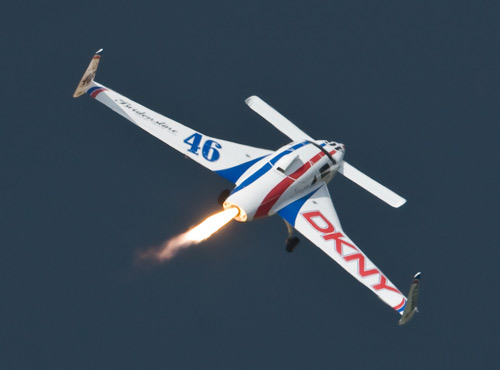Part One of Two Parts
Continuing my coverage of commercial space enterprises, this blog is going to focus on a company called XCOR Aerospace. The company was founded in 1999 as a privately-held California C Corporation. From a staff of four working in a small hanger, XCOR has grown to a staff of fifty housed in a ten thousand square foot hangar located in Mohave, CA. XCOR is "focused on the research, development, project management, production and maintenance of safer, more reliable, reusable suborbital and orbital launch vehicles (RLVs), rocket engines and rocket propulsion systems." The company has designed and built thirteen different rocket engines. It has built and flown two manned aircraft powered by rocket engines.
The EZ-Rocket was the first XCOR demonstration rocket-powered aircraft and it was completed in 2001. It was the first vehicle of its type that was built and flown by a non-governmental organization. The twin engines were fueled by liquid oxygen in an internal tank and isopropyl alcohol in an external fuel tank. The small aircraft body is shorter than the wingspan. The engines are easy to stop and restart and the plane can glide for long distances without the engines on. Maximum speed is two hundred and twenty five mile per hour with a ceiling of over eleven thousand feet. Operation is reliable and inexpensive.
XCOR expertise contributed to the passage of the Commercial Space Launch Amendments Act of 2004. This U.S. Congressional bill applies to private space flight which is considered to be flight above the nominal edge of space at sixty two miles above the earth undertaken by an entity other than a government agency.
In 2008, XCOR built the X-Racer under contract with the Rocket Racing League. The airframe was purchased from the Velocity company in Florida. Its single engine is fueled by kerosene and liquid oxygen. The maximum speed is around two hundred and thirty miles per hour and maximum altitude reached is almost thirteen thousand feet. One of the important features of the X-Racer is the ability to be refueled in under ten minutes which allows it to make multiple flights in a day. The X-Racer was the first XCOR vehicle to employ their proprietary rocket propellant piston pump.
Most conventional rocket engines use turbo-centrifugal pumps to mix the fuel and oxidizer and feed the mixture to a separate engine. XCOR began developing a piston based pump in 2003. After years of development with the help of DARPA grants they evolved a free piston pump and engine combination that was light, compact, efficient and inexpensive. It can be turned on and off easily during flight. It was designed to mix liquid oxygen and kerosene but can also be used with other fuels and oxidants. The XCOR revolutionary propellant piston pump allowed them to create a light and efficient vehicle.
In Part Two of this post, I will discuss the Lynx suborbital launch vehicle, the latest project of XCOR.
(See Part Two)
XCOR X-Racer in flight:
